Garden Glimpses: Mid-Winter 2022
Winter can seem a very bleak period, but there’s beauty and wonder everywhere, if you know where to look for it. Last year we had a blizzard in late January, which dropped more than 30 inches on the property, and kept it snowbound until mid-March. In my youth, this used to be the natural state of things in my area, snow cover from Christmas to Easter, but climate change has made that a rarity. The year before there was no measurable snow accumulation the entire season, and this year, though we’re still running below average, we’ve managed to have a series of smaller snowfalls which, aided by bitter cold spells, have helped to keep the ground covered throughout January, if only by a few inches.

Snow cover is important for the garden’s ecosystem, especially when temps drop well below freezing for extended periods. It provides protection for exposed or shallow plant roots, insulation for the creepy-crawly critters that overwinter at the base of perennials, and even hydration for the birds, who can peck at the snow for moisture when standing water has turned to ice.

And let’s face it – as much of a pain in the ass as snow can be for accomplishing human pursuits, it’s one of the loveliest things you’ll ever see. We were blessed this year with a number of different varieties of snow. Not to go all Inuit on you (I have only one word for the white flakes that fall from the sky, not the 40+ which indigenous peoples created), but snow can express itself in several ways. Soft, powdery snows which fall in absolute stillness, then are carved into whorls and canyons and peaks of drifting white by strong winds that follow after the storm has passed. Or firmer, heavier snows which beg to be rolled into projectiles aimed at unwary passersby, or stacked into anthropomorphic shapes, bedecked with scarves and caps, button eyes and carrot noses.
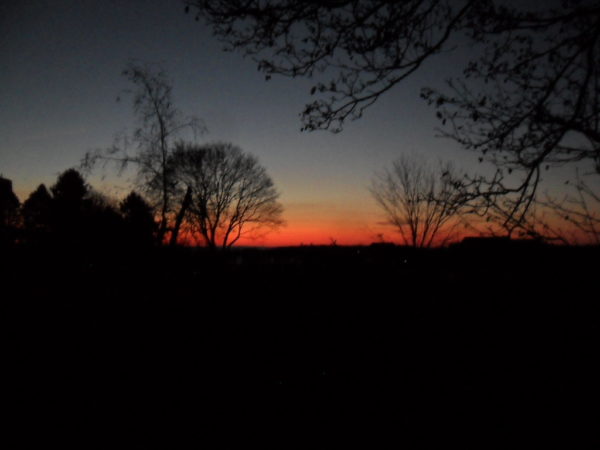
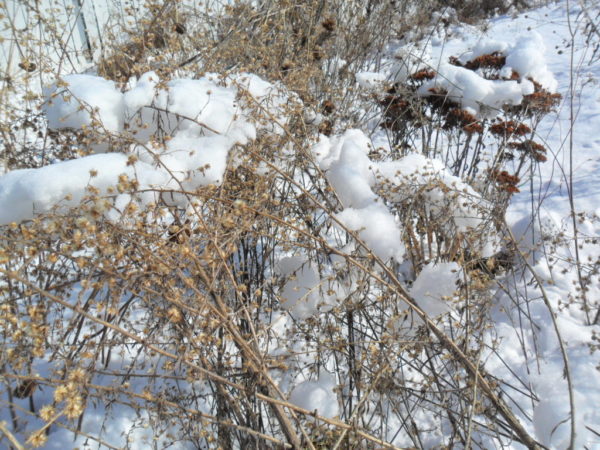
Snows that cling to branches and the skeletal remains of summer’s bounty, until the whole yard seems like some frosted fairy land, then drip and plop mournfully to the puddled ground as a waxing sun warms them off their precarious perch. Snows that mound on the dried spent heads of sedum, Queen Anne’s lace, echinacea or monarda, tapering upward like so many pyramids until time and gusty breezes wear them down. Dry snows that whip and whistle around corners and across bare turf, snaking like serpents coiling to strike; wet snows that freeze into veritable blocks of ice that resist even the sunniest of days.
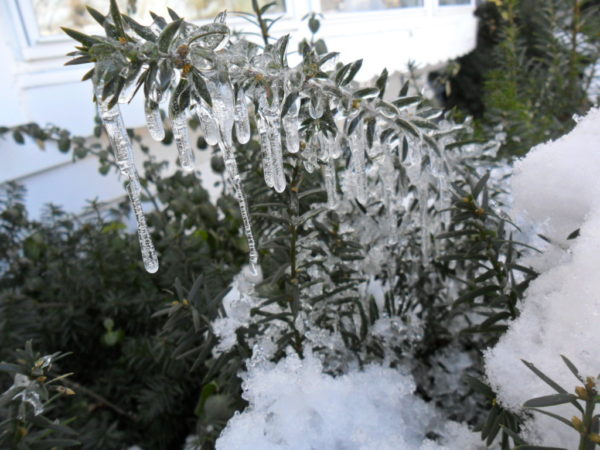
Ice is another vibrant element of the season. The clicking ting-ting-ting of sleet as it lashes against the window pane; the glittering tapers that hang from eaves and rainspouts like fangs or talons of some hidden dragon; freezing rain that falls as liquid but glazes everything it touches in sparkling crystal, lit to dazzling intensity by the rising sun, or glowing amber as it sets. We’ve had just one ice storm here so far this season, and mercifully, for the sake of the energy infrastructure, it was a light one, just a tenth of an inch. But that was enough to encase the meager 3” snowfall already on the ground, preserving it for a week longer than it would have lasted otherwise, protected from the sun’s warmth by the hard, crusty coating. The sunlight glittering in the trees was stunning, like diamonds strung by woodland elves.
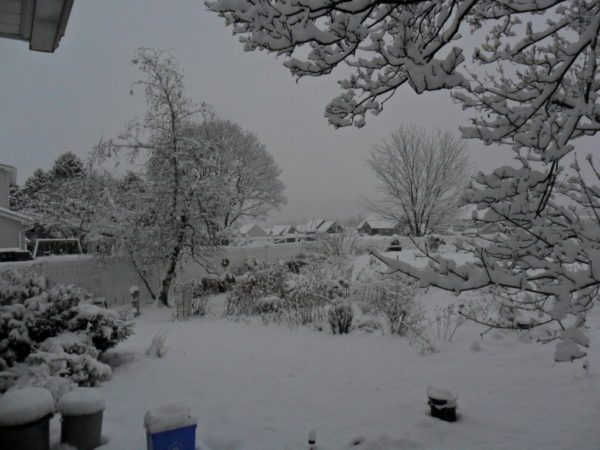
I enjoy the paler light of winter, not so harsh and revealing as the summer sun. The rosy purple blush above the horizon at dawn; the bleached salmon skies of a winter dusk. Sunrises have been especially beautiful of late, with vivid panoplies of color, rapidly changing in kaleidoscopic splendor as the sun races to emerge over the skyline into the crisp-clear brilliance of a cold winter’s atmosphere. Venus has been starkly visible pre-dawn, an impossibly bright, beaming burst of light, gradually fading into the sun’s glow, and my old friend Orion the Hunter, the first constellation I could identify, arcs boldly across the darkest night. And how wondrous the shadows of branches on the snow when a wintertime full moon is shining through the bare trees!

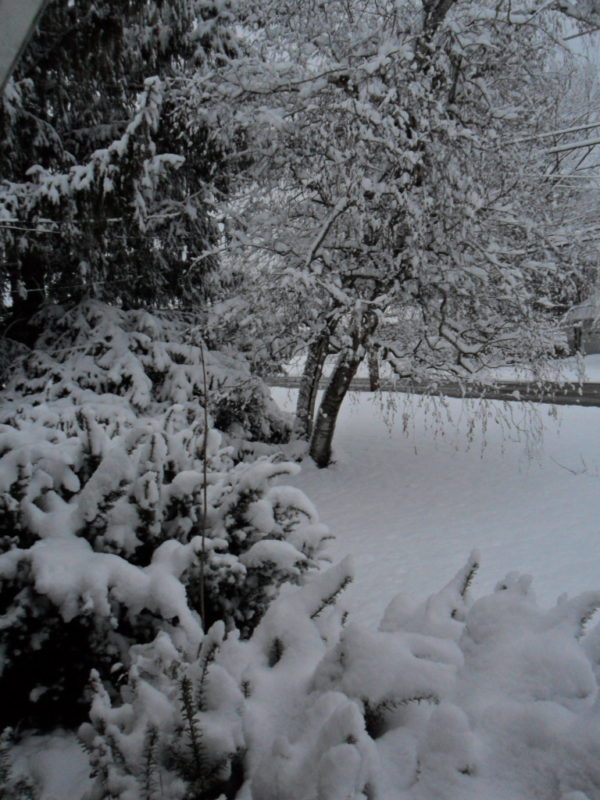
There’s not much to the color scheme in the yard right now except white, tan and brown, but there are still some islands of green from spruce, yew, juniper, boxwood and holly, while false cypress’ yellow-green branches light up the landscape. Holly berries add a pop of red, but the winterberries have softened and darkened, the red chokeberries have turned maroon-brown, and beauty berry’s fruits are shrunken ghosts of themselves, dun-colored vestiges of their showy purple autumn selves.
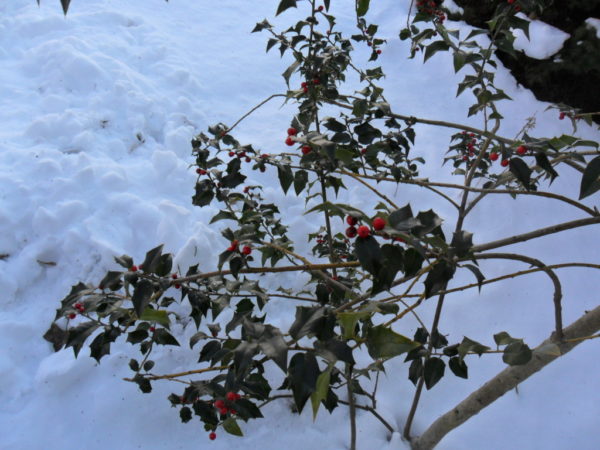
But close inspection of the witch hazel reveals swelling of the buds, which will burst forth in brilliant yellow before too long, the earliest shrub or tree to flower in these parts. Forsythia lags behind, but can be forced, and several branches brought indoors less than a week ago are already beginning to show movement and pale-yellow color. As I trod the grounds with a friend last week during the temporary thaw, the ground squished with moisture beneath our feet, a stark contrast to the pleasant crunch of frozen turf we’ve had since Yule, and I was surprised to see early evidence of the coming bulbarama, with bladed tips of crocus, iris reticulata, mini daffodils and even hyacinth poking through the soil. These are just the point of the spear, with some 1800 bulbs waiting to grace the garden in the months to come.
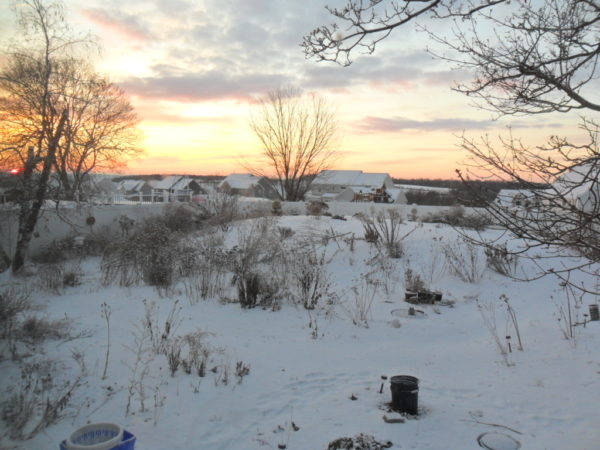
A survey of winter’s joys wouldn’t be complete without reference to the fauna. While the insect kingdom slumbers and many mammals hibernate, with some birds flying south to vacation in gentler climes, there’s still plenty of activity in the yard.
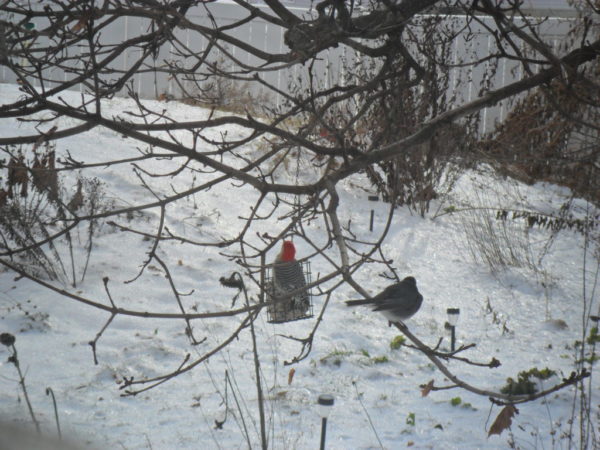
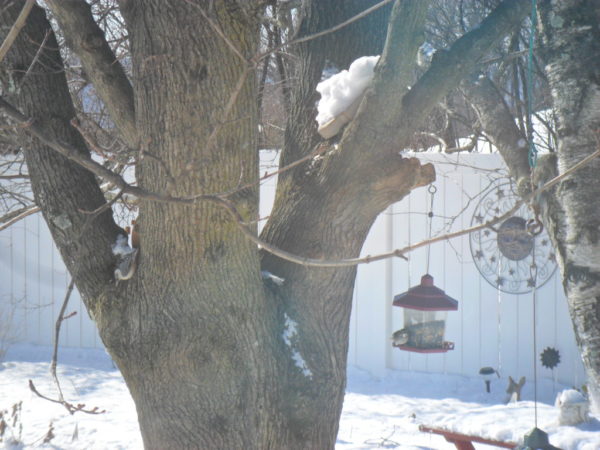
This is especially true here now, with the fallow fields behind the house, which used to provide sustenance and shelter for the local biota, torn up for housing. My fenced garden has become a magnet for wildlife, being one of the few remaining sites to garner a square meal for those uprooted communities, a haven bursting with natural and imported comestibles. In addition to the mixed seed and black oil sunflower seeds which I provide in four feeders, there are three cage feeders for suet, as well as a wide range of native seed, from dried pokeberry fruits to echinacea and monarda seed heads, thistles and asters, each a favorite of different species. I purposely delayed my autumn clean-up of the garden until late winter and early spring, to accommodate the native seed lovers and provide shelter for others.
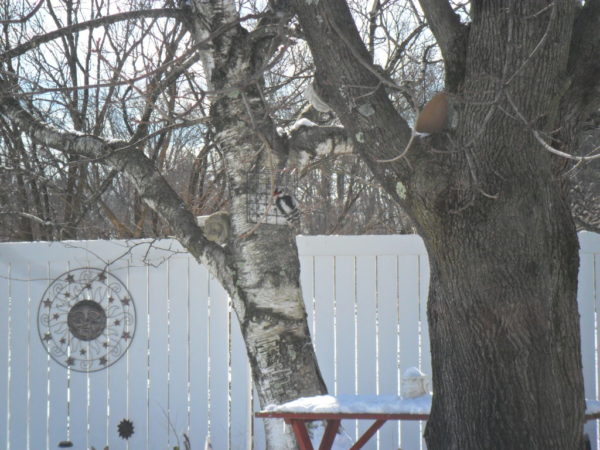
Particularly when the garden is snowbound, these feeders become hubs of raucous activity, with blue jays, cardinals, titmice, chickadees, house finches, wrens, sparrows, nuthatches and mourning doves vying for the choicest morsels. Placed strategically so as to be best viewed from house windows, bird watching at these feeders in the garden consumes many delightful winter hours. I especially enjoy seeing the woodpeckers, with the diminutive 6” Downy my personal favorite. Banded brilliant white and ebony, the males have a dot of red on their caps, and cavort with glee, flitting from suet to branch to tree trunk, where they probe deeply with their elongated beaks for hibernating insects. Downys are by far the most common variety, but we’ll see red-bellied and red-headed woodpeckers from time to time as well, and this year I lured a Flicker for the first time, another woodpecker species, with a cream-tan breast speckled in brown, banded black and brown wings, and a bright red cap. Nuthatches’ comical backwards dance as they negotiate trunks in reverse adds to the fun, while some of the tamer chickadees will come right up to the kitchen window and peer intently at me, as if offering thanks for the vittles.

I have one squirrel who comes regularly to raid the feeders, one of which (the smallest!) I have placed close enough to the trunk for him to reach easily. He’s not the intended target of my feeding, but squirrels have to eat, too, and I don’t really mind his theft, except on the rare occasions when he brings his friends. That rodent brunch can clean me out!
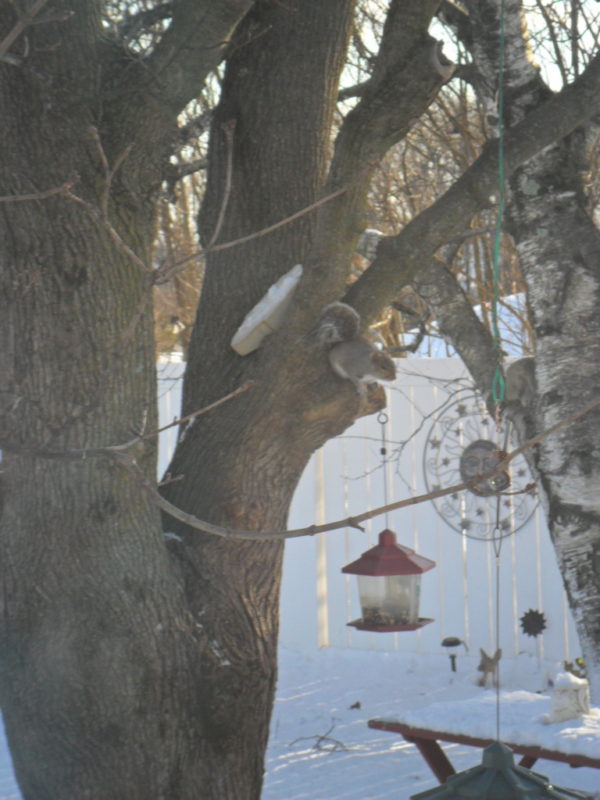
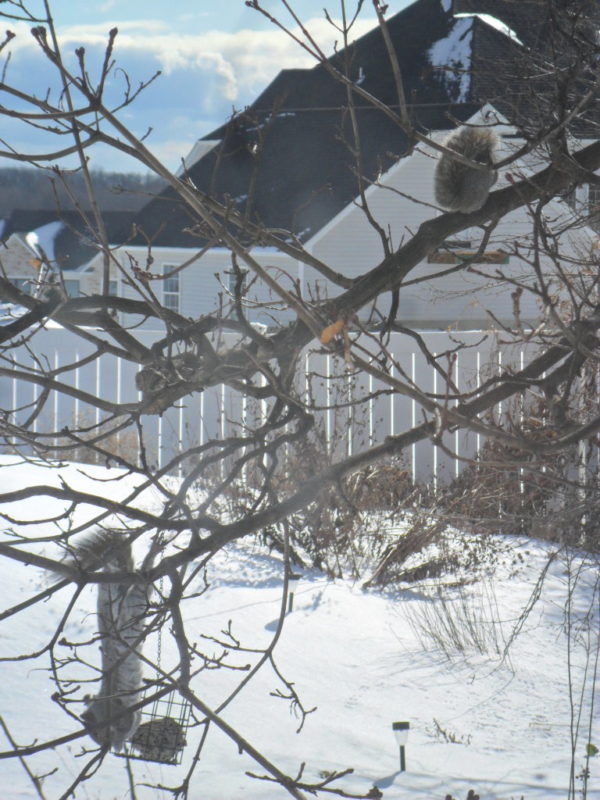
The vole is typically well hidden now, but I’ll see the evidence of his survival in the tunneled grass paths once the snow has melted. I got a face-to-face with him a few weeks ago when I had left via the garage to check the mailbox. The little intruder took advantage of the wide-open door to scamper into the comparative warmth of the garage, where he quicky hid himself in the detritus of my move, still stacked in front of the car. No amount of shooing and spooking would flush him, but thankfully I had closed the door to the laundry on my way out, so he couldn’t progress further into the house. There’s no food or water source in the garage, and I left the door open for several hours after, so hopefully he moved out quickly, though for all I know, he could have moved his family in!
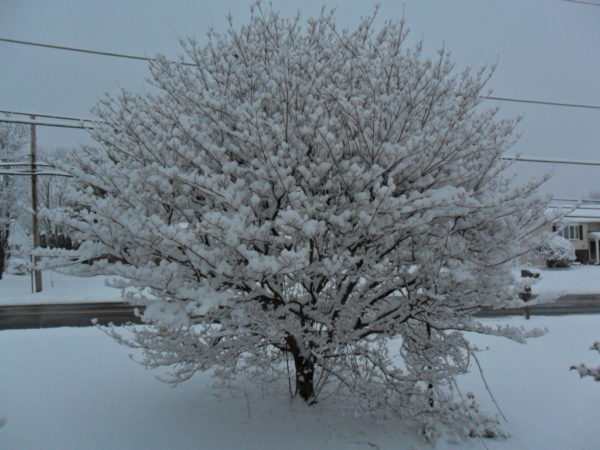
The days are waxing longer now toward Ostara’s equilibrium of light and darkness, and the sun’s rays shine more warmly. We had a complete melt-out in early February following a warm rain, but within a week an unexpected six-inch snowfall put things to rights again, at least temporarily. It’s been a nice winter, a good winter, but the promise of spring just around the corner gladdens the gardener’s heart within me.

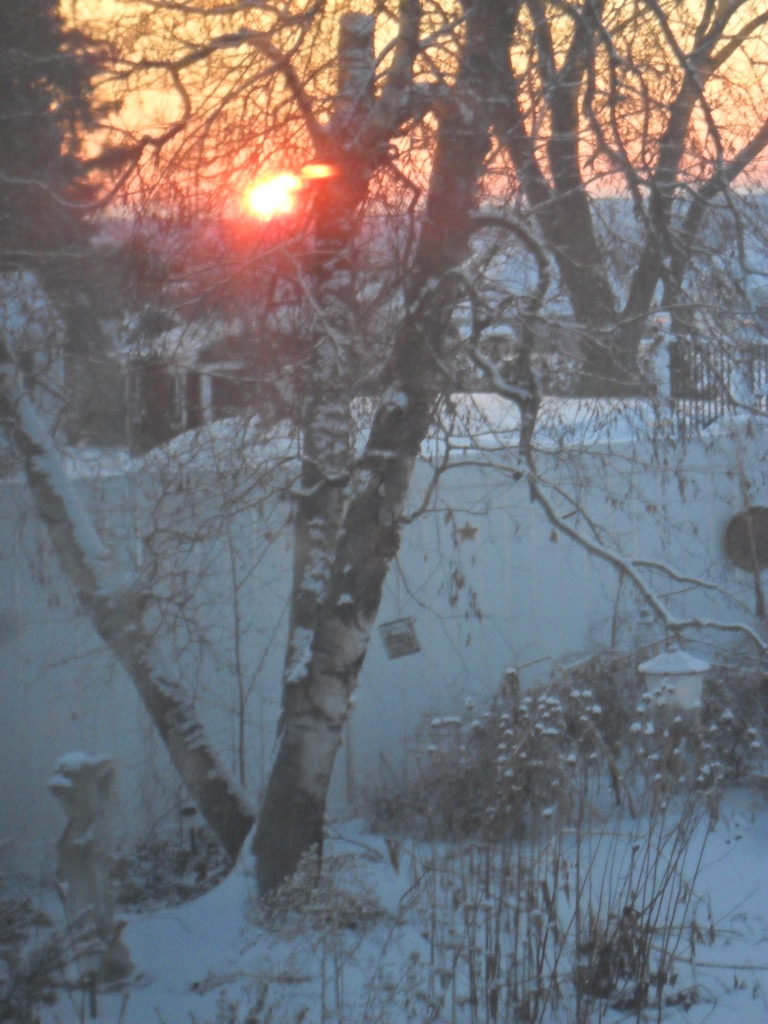

3 comments, add yours.
Laurien
Lovely, Alex! I enjoyed both your photos and your prose. Glad so many creatures are welcome in your garden. 1800 bulbs qualifies as a bulbarama indeed! Will look forward to seeing your spring photos when they all come up! Thanks for sharing!
Jacqueline Janes
Winter is my favorite season, Alex. Your lovely pictures, with perfect prose to describe the beauty available when one really sees the winter garden with a poet’s eyes, warmed my heart. And, indeed, snow has many textures to appreciate. I love all your garden visits, but this was a definitely my favorite garden walk.
Emma Esperanza Acosta
Gracias por esa linda descripción de la caída del hielo y demás, me gusto, Esperanza